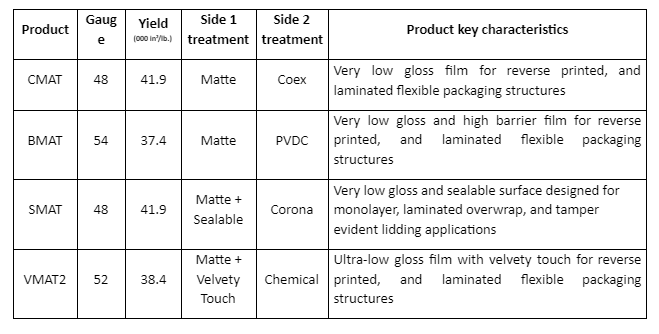
Terphane´s matte and velvety-touch BOPET films enable brand owners to achieve a new look and feel for their packaging.
Bloomfield, NY – One of the key challenges of packaging design is making your product stand out on the shelf amongst dozens of options. This requires that consumers notice the products and then get it in their hands.
Terphane has your solution. “Our matte-finished film is associated with healthier and more sustainable products, particularly when compared side-by-side with older, glossy alternatives. Consumers accept the matte-finish package as a more natural and trustworthy option,” explained Ezra Bowen, Sales Manager of North America with Terphane. “Our matte films bring an additional advantage: ease of reading all the different information required on the packaging, including nutritional facts, ingredients, recipes, and more. Our film’s non-chemical, anti-glare surface makes it a lot easier for consumers to review the information, which interests them and has a positive impact,” added Bowen.
Terphane´s portfolio consists of four main products with matte finish and texture effects. All are FDA/EEC approved for food contact, including high temperature applications.

“On launching our first coextruded printable matte film, the immediate market demand was astounding,” explained Marcos Vieira, Global R&D Director for Terphane. “Now, we are meeting the demand for more value-added products by adding to our portfolio the barrier (BMAT) and sealable (SMAT) matte films,” Vieira continued. “Recently, we´ve designed VMAT2, our new velvety touch matte film, which brings not only an ultra-low gloss and high transparency but also a unique proprietary velvety touch haptic,” Marcos said. “Simply stated, you have to see and touch the film – you will be amazed.”
“The trend for haptics in packaging is growing fast with some estimates of up to 15%, making it the fastest growing segment in the US,” stated Bowen. “There´s a wide range of demand for Terphane matte films, especially in the luxury packaging market. We have proven solutions for many different segment, such as, pet food, snacks, nutraceutical, confectionary, frozen food, wet wipes, dairy products, processed meat, coffee, berries, ketchup, soap bars and liquid soap, and many more,” explained Ezra.
